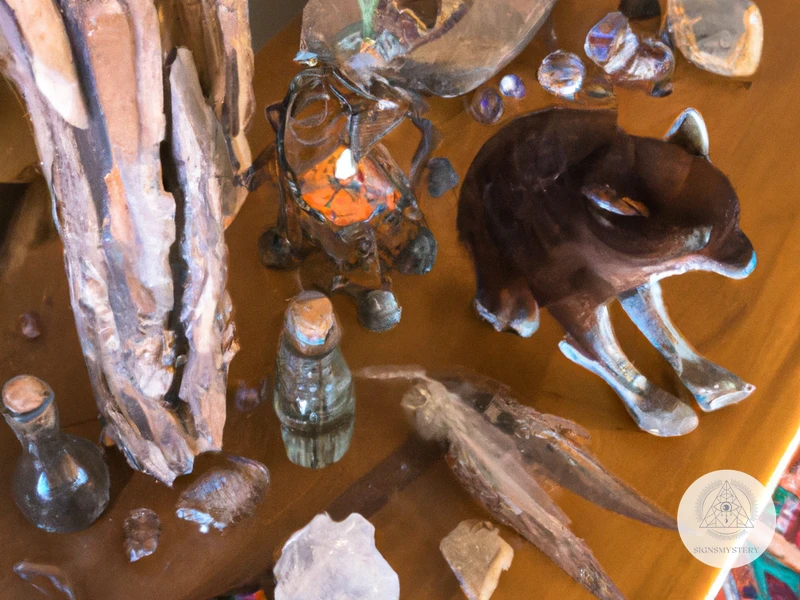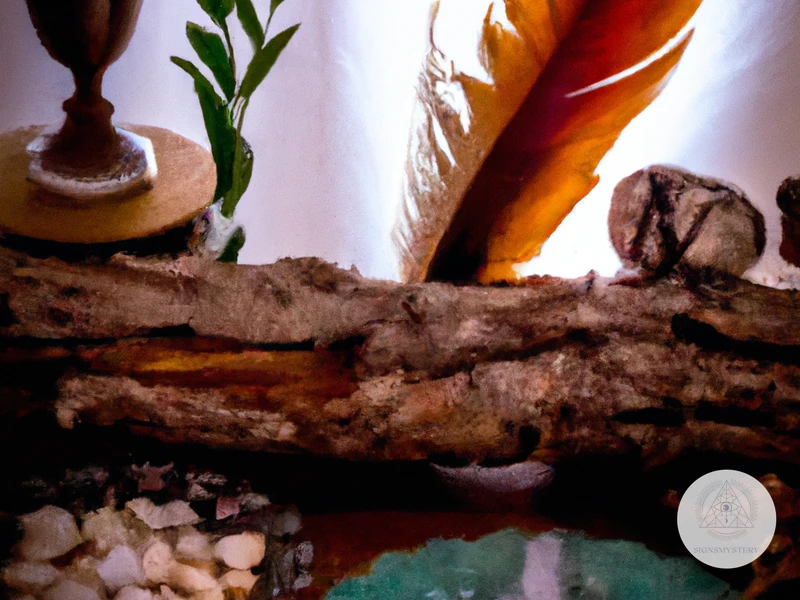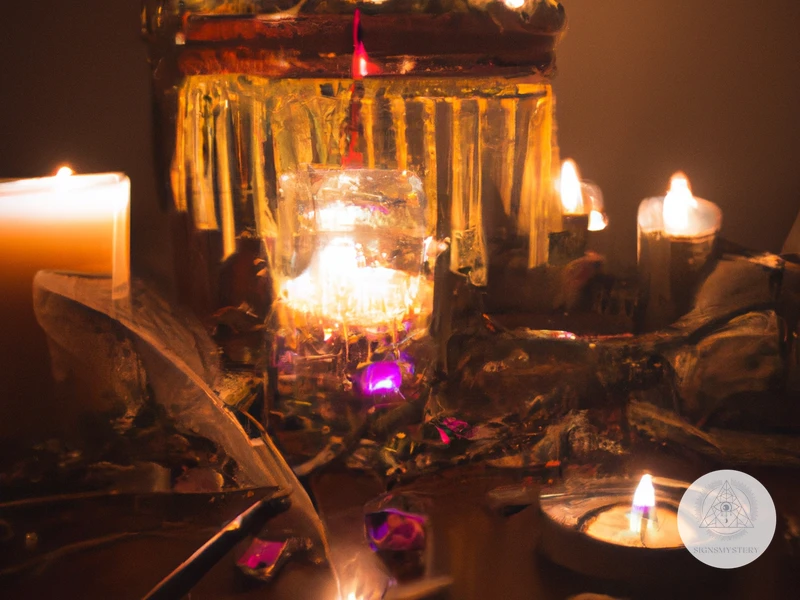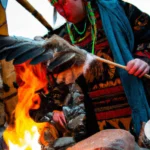A shamanic altar is an essential tool used in many ritual ceremonies for connecting with the spirit world and creating a sacred space. The power of the shamanic altar lies in its ability to facilitate a connection between the physical world and the spiritual realm. This connection is made possible through the intentional arrangement of sacred items and through the shaman’s focused intention. Creating and using a shamanic altar is an ancient practice that has been passed down through generations, and it continues to hold relevance in many contemporary spiritual communities. In this article, we’ll explore the traditional components of a shamanic altar, the purpose of the altar in ritual ceremonies, how to create your own altar, and how to maintain and honor it over time. By the end of this article, you’ll have a deeper understanding of the meaning and purpose of the shamanic altar in spiritual practices.
What is a shamanic altar?

A shamanic altar is a sacred space that is used for spiritual connection and ritual practices in shamanism. It serves as a focal point of power and intention during ceremonies and can be made up of traditional components such as feathers, crystals, and herbs. In addition to an array of symbolic objects, the altar also represents a connection to the spirit world and personal power. Building and maintaining this altar involves certain traditions and rituals such as smudging, grounding, and preparing oneself before working with it. Through the use of music, chanting, and divination tools, shamans make use of the altar as a platform for communicating with the spirit realm and with higher realms of consciousness.
Traditional components of a shamanic altar
Traditional components of a shamanic altar typically incorporate several sacred items and symbols that have special significance in shamanic practice. Below are the main components of a traditional shamanic altar:
| Sacred Item/Symbol | Meaning |
|---|---|
| Feathers | Represent the air element and are used to fan the spirit or to call upon the spirits of the air. |
| Bones | Represent the earth element and are believed to connect the shaman and the spiritual realm. They also serve as a reminder of mortality and spirituality. |
| Crystals and gemstones | Are believed to have healing properties for the mind and body and serve as conductors for energy between the spiritual realm, the altar, and the shaman. |
| Drums/rattles | Help create a shamanic state of consciousness through their rhythmic beat. They are also used to communicate with the spirits. |
| Candles | Represent the fire element and serve as a symbol of illumination and spiritual enlightenment. They can also be used to purify the space during a ritual. |
| Herbs & plants | Represent the water element and are used for their healing and cleansing properties. They can also be used for protection and to enhance spiritual connections. |
The specific items and symbolism used in a shamanic altar may vary according to cultural and personal preferences. However, they are all chosen with intention and are believed to hold spiritual power that helps connect the shaman to the spiritual realm and the world around them. Understanding the traditional components of the shamanic altar can help you develop a strong spiritual practice and deepen your connection to the spirits.
Importance of setting up an altar with intention
Setting up a shamanic altar with intention is of utmost importance for any shamanic practitioner. The intention behind the altar sets the tone for the entire practice and determines its effectiveness. The shamanic altar serves as a portal between the physical and spiritual realm, and the practitioner must establish the proper intention to ensure that the altar connects with the spiritual world.
The intention behind the altar can be as simple or complex as the practitioner desires. One may choose to set up an altar as a space to honor ancestors, to connect with a specific spirit guide, or as a place to connect with the natural world. Whatever the intention behind the altar, it should be thoughtfully considered and purposefully established.
When setting up the altar, the practitioner should be mindful of every item they choose to include. Each item should be chosen with a specific intention in mind and play a role in the overall purpose of the altar. The way the items are arranged on the altar is also important as it can affect the energy flow and create a more powerful connection between the physical and spiritual realms.
In addition to setting up the altar with intention, the practitioner should also approach the altar with a clear and focused mind. A shamanic practitioner should take the time to clear their mind and focus on their intention before approaching the altar. This can be done through meditation, drumming, or chanting, among other practices.
Setting up a shamanic altar with intention is crucial for any shamanic practice. A well thought out and intentional altar can create a powerful connection with the spiritual realm, allowing for a deeper and more meaningful practice. The practitioner should be mindful of the intention behind the altar, the items chosen, and their mindset when approaching the altar. By doing so, the shamanic practitioner can create a space that supports their practice and facilitates their connection to the spiritual world.
The Purpose of a Shamanic Altar
is multi-faceted, as it serves a variety of functions in shamanic practice. One of the primary purposes of the altar is to create a sacred space for ritual. By setting up an altar with intention, shamanic practitioners can stimulate their connection with the spirit world and access higher levels of consciousness. Altars can also be used for storing personal power objects, as they serve as a physical representation of the practitioner’s spiritual journey. Additionally, altars can be used to connect with the spirit world, and provide a focal point for meditation and offerings. Whether using drumming, chanting, or hallucinogens, shamanic practitioners can achieve heightened altered states of consciousness through their use of the shamanic altar.
Creating a sacred space for ritual
Creating a sacred space for ritual is a crucial part of setting up a shamanic altar. The first step towards creating a sacred space is choosing a location that feels safe and comfortable. This location could be indoors or outdoors, depending on the specific needs of the ceremony.
Once a location is chosen, it’s essential to clear the space of any physical and energetic clutter. This can be done in several ways, including smudging with sage or palo santo, playing music or chanting, or simply using your intention to clear the space of negative energy.
After the space is cleared, consider adding elements that will help set the tone for the ritual. This might include incorporating natural elements such as rocks, plants, or water, or perhaps setting up a specific altar with candles, crystals, or other sacred objects.
It’s important to approach the process of creating a sacred space for ritual with intention and focus. Remember, this space is being created to help facilitate your connection with the spirit world and should be treated with respect and reverence.
Finally, once the sacred space is created, take a moment to center yourself and connect with your intention for the ceremony. This might involve a period of quiet meditation, drumming, or other ritual preparation.
Internal link to: /drumming-shamanic-rituals/
Connecting with the spirit world
is perhaps the most important aspect of shamanic practice, and the shamanic altar plays a key role in this process. It serves as a bridge between the physical and spiritual realms, providing a point of focus for spiritual energies and enabling the shaman to communicate with spirit guides and ancestors.
One way to connect with the spirit world is through the use of hallucinogenic plants and other entheogens, which are used in many shamanic cultures to induce altered states of consciousness and facilitate contact with the spirit realm. Another method is through music and chanting, which can help to induce trance states and connect the shaman with the energies of the earth and sky.
Before attempting to connect with the spirit world, it is important to engage in a process of purification to clear the mind and body of impurities and distractions. This might involve fasting, bathing, or performing other cleansing rituals to prepare for the spiritual journey ahead.
Once the shaman is ready to make contact with the spirit world, they can use a variety of techniques to facilitate this process. These might include entering a state of trance through dance or meditation, or using divination tools such as a pendulum or tarot cards to communicate with the spirit realm.
Whatever methods are used, the key to successful spirit communication lies in maintaining an open and receptive state of mind and heart. By staying present and focused during the process, the shaman can receive guidance and insights from the spirit realm that can be used to promote healing, personal growth, and collective transformation.
At the end of the process, it is important to offer gratitude to the spirit guides and ancestors who have helped along the way. Many shamans will offer small gifts or sacrifices as tokens of appreciation, such as herbs, food, or other objects that hold personal significance.
The shamanic altar serves as a powerful tool for connecting with the spirit world and facilitating communication with spirit guides and ancestors. By engaging in this process with intention and openness, the shaman can receive guidance and insights that can help to promote healing and transformation in their own lives and in the lives of those around them.
Storing personal power objects
on your shamanic altar is another essential aspect of shamanic practice. These objects can be anything that holds personal significance and power, such as crystals, feathers, bones, or other natural items. They can also be items that have been gifted or passed down from ancestors or teachers.
The act of placing these objects on your altar imbues them with even more power and significance. The altar becomes a repository for the energy and intention that you’ve imbued into these objects. Whenever you’re feeling disconnected from your power or in need of an energetic boost during your shamanic practice, you can turn to these objects for guidance and support.
Through the power of trance, you can connect with the energy of the objects on your altar and tap into their inherent power to help you on your journey. Additionally, working with personal power objects helps to deepen your connection to the natural world and can serve as a reminder of your connection to all living things.
It’s important to note that the objects you choose to place on your shamanic altar should be chosen intentionally and with great care. They should hold personal significance and meaning to you, and should be cleansed regularly to keep their energy pure and strong.
Storing personal power objects on your shamanic altar is an important and meaningful practice that can help you deepen your connection to yourself, the natural world, and the spirit world. By imbuing these items with your intention and regularly working with them, they become powerful allies on your shamanic journey.
Creating Your Own Shamanic Altar

When creating a shamanic altar, it’s important to choose a location that feels sacred and private. This could be a corner in a room or a specific outdoor spot. Once a location is chosen, gather items that hold personal significance, such as crystals, feathers, shells, and pictures. These items can be arranged on a table or on the ground, but it’s important to consider the traditional components of a shamanic altar, such as the four directions and the elements. Placing items that represent each direction (north, south, east, west) and elements (earth, air, fire, water) can enhance the power and intention of the altar. Consider incorporating a smudging ritual with sage or palo santo to cleanse the space before and after use. Remember that the altar is a living entity and should be honored and cared for regularly. For more ideas on how to incorporate shamanic practices into daily life, check out shamanic rituals for healing ailments, learn about the four directions, or include fire and smoke in your shamanic rituals by reading more about it here.
Choosing the right location
When creating a shamanic altar, choosing the right location is crucial. It should be a space where you feel grounded, safe, and spiritually connected. The location of the altar will determine the energy and intention that is brought to the ceremony.
The best location for a shamanic altar is a quiet, private, and undisturbed area of your home or property. It should be a place where you can meditate and connect with the spirit world without distractions. Consider placing your altar near a window or natural light source to connect with the energy of the sun and moon.
When choosing a location, take into account any environmental factors that may influence the ceremony. For example, if you choose to have an outdoor altar, be mindful of the weather, wind, and sunlight. A stable and level surface is also important to create a sturdy foundation for your altar.
The location of the altar should align with the intention of the ceremony. For example, if you are performing a healing ritual, choose a location that is soothing and peaceful. If you are conducting a ceremony for abundance or prosperity, choose a location with a view of nature and growth.
Choosing the right location for your shamanic altar involves careful consideration of the energy, intention, and environmental factors. Take the time to find the perfect location to create a sacred space for your spiritual practice.
Selecting altar items
Selecting the perfect items for your shamanic altar can be a perplexing process. Start by considering the purpose of your altar and any specific intention you have for your practice. The items you choose should hold personal significance and symbolism to help you connect with your spiritual practice.
Crystals and stones: Choose crystals and stones that resonate with your intention for the altar. Amethyst and clear quartz are both popular choices for promoting spiritual connection and intuition, while black tourmaline is used for protection.
Feathers: Feathers are often used in shamanic practice to represent the element of air and to connect with spirit guides. Choose feathers that have special significance to you or that you have found during your journeys.
Drums and rattles: Musical instruments such as drums and rattles can be used to create a sacred sound during ritual ceremonies. Choose an instrument that speaks to you and that you feel comfortable using.
Candles: Candles are often used to represent the element of fire on an altar. Choose candles in colors that align with your intention, such as red for passion or green for abundance.
Statues and figurines: Statues and figurines can represent deities, animal spirits, or other spiritual guides. Choose items that resonate with your personal beliefs and spiritual practice.
Offering bowls: Offering bowls can be used to hold herbs, crystals, or other offerings during ceremony. Choose a bowl that speaks to you and that you will enjoy using during your practice.
Remember, the items you choose for your shamanic altar should be personal to you and should have significance in your spiritual practice. Don’t be afraid to choose unique or unconventional items that hold special meaning to you.
Setting up the altar
When setting up your shamanic altar, it is important to consider your intentions and what you hope to achieve through its use. Begin by choosing a location for your altar that is quiet and sacred, free from distractions, and easily accessible to you.
Once you have settled on a location, cleanse the space by wafting sage or palo santo smoke around the area and setting protective boundaries with salt or crystals. These actions will purify and safeguard the space of your altar, making it more conducive to spiritual work.
When it comes to selecting items for your altar, you can choose from a variety of traditional pieces such as power animals, crystals, feathers, candles, herbs, and other natural objects. It’s important to choose objects that hold significance to you and or feel intuitively right to include on your altar.
You may also wish to include a representation of the four elements: earth, air, fire, and water. This balance can be achieved through the use of specific objects such as rocks and crystals for earth, feathers or incense for air, candles or other fire symbols for fire, and a small bowl of water for water.
Once you have gathered your items, arrange them according to your intuition and creativity. The layout of the altar often reflects the individual’s personal spiritual beliefs and relationships with the spirit world. Reflect on placement and use the power of symmetry, alignment, and symbolism to create a harmonious and balanced arrangement.
Once your altar is set up, it can be used for spiritual work, healing practices, or simply as a space of reverence and connection with the spirit world. Remember to approach your altar with respect and reverence, as it is a powerful tool for spiritual growth and transformation.
How to Use a Shamanic Altar in Ceremonies
Using a shamanic altar during ceremonies is a powerful way to connect with the spirit realm and create sacred space. To start, prepare the altar by cleansing it with smoke or other purifying methods. During the ceremony, set your intention and call upon the spirits to join you. Place offerings such as tobacco or other sacred herbs on the altar as a sign of gratitude and respect. Use the altar as a focal point during the ceremony, perhaps lighting candles or directing energy towards it. When closing the ceremony, offer thanks to the spirits and the altar, and remove any offerings or objects before cleansing the altar once again. Remember to always approach the altar with respect and mindfulness, as it is a sacred tool for spiritual connection and growth.
Preparing the altar for ceremony
Preparing the shamanic altar for a ceremony is a crucial step in the ritual process. It sets the sacred space and creates a suitable environment for connecting with the spirit world. Before starting the preparation process, it is essential to ensure that you have all the necessary components to perform the ceremony.
Begin by cleaning the space where you will set up the shamanic altar. You can use organic cleaning supplies like vinegar and water or smudging with sage or palo santo to energetically cleanse the area. Once the area is clean, select a low table or surface to use as the altar.
Before placing any items on the altar, take a moment to connect with your intention for the ceremony. Consider the energies or spirits you want to invoke during the ceremony and select items that will help you to connect with these energies.
Start by placing the main power object that represents your intention for the ceremony in the center of the altar. This item could be a crystal, a statue, or a symbol that represents the spirits you are working with. Next, place candles or other sources of light around the center object. Light is an essential component of a shamanic ceremony, as it symbolizes both illumination and protection.
Add fresh or dried flowers or other natural elements such as stones or feathers to connect with the natural world. Arrange them in a way that feels intuitively pleasing. You can also add personal objects like photographs or keepsakes that have deep meaning for you.
Once you have arranged all the items on the altar, take a moment to connect with each one, and offer gratitude for its presence. You can also smudge each item with sage or palo santo to cleanse and charge it with positive energy.
Remember to honor the presence of the shamanic altar and the spirits you have called upon during the ceremony. It is also essential to close the ceremony properly and clear the space to ensure
Subscribe to Our Newsletter
Sign up to receive the latest news and updates.
Working with the altar during ceremony
Working with the altar during a ceremony is a deeply personal and intimate experience. It requires a certain level of focus and intention on the part of the practitioner to fully connect with the energy of the altar and the spirits it represents.
There are several ways to work with the altar during a ceremony:
| Method | Description |
|---|---|
| Offering | During the ceremony, a practitioner may offer items such as flowers, herbs or crystals as a symbol of gratitude and respect to the spirits represented at the altar. |
| Meditation | Practitioners may sit before the altar in a meditative state to connect with the spirits represented and receive inspiration and guidance during the ceremony. |
| Prayer | A shamanic ceremony often involves prayer to the spirits represented on the altar. A practitioner may light candles or burn incense as a way to focus their intentions and connect with the spirits during prayer. |
| Divination | Many practitioners use shamanic altars for divination purposes during a ceremony. They may use tools such as Tarot cards or runes to receive guidance from the spirits represented on the altar. |
| Petitioning | A shamanic altar may be used to request blessings or help from the spirits represented. Practitioners may write down their intentions or requests and leave them at the altar during the ceremony. |
It is important to remember that the altar is a sacred space and must be respected as such during the ceremony. Practitioners should approach the altar with a clear mind and with intentions that are respectful and focused. Each action taken at the altar should be done with care and purpose.
As the ceremony progresses, the altar may begin to radiate a special energy that can be felt by the practitioner. This energy can be harnessed and used to strengthen their connection with the spirits and the spiritual realm.
Working with a shamanic altar during a ceremony is a powerful experience that can deepen a practitioner’s connection to the spiritual world. By approaching the altar with respect and intention, practitioners can tap into its power and receive the guidance and support they need to achieve their goals.
Closing the altar after ceremony
Closing the shamanic altar after a ceremony is just as important as setting it up. This is the time to show gratitude for the spirits that have been summoned and to release them from the space. Here are some steps to follow:
- Disassembling the altar: Start by carefully removing all items from the altar and placing them in their respective containers or bags. Remember to thank each item and offer a blessing before putting them away.
- Cleansing the space: Use the same method of smudging or other cleansing ritual as when setting up the altar. Start at the back of the room and move towards the door, cleansing every corner and surface until you reach the altar space.
- Closing the elements: Begin by thanking the spirits of the four directions and elements for their presence and protection during the ceremony. Use a feather or other tool to represent the direction and element. For example, use the feather for the east (air) and say “Thank you, Spirit of the East, for bringing the element of air and the power of new beginnings to this ceremony. Your energy is released, and you are free to go.”
- Thanking the ancestors and spirits: Remember to thank the ancestors, spirit guides, and any other spirits that were called upon during the ceremony. Offer them gratitude and ask for their continued support and guidance in your spiritual journey.
- Dismissing the spirits: It is important to dismiss any spirits that were called upon during the ceremony so that they do not linger in the space and cause any disturbances. Use a respectful tone and acknowledge their power, but firmly tell them that the ceremony is over and it is time to go.
- Closing the circle: If a circle was cast during the ceremony, it is important to release that energy and close the circle. This can be done by simply walking clockwise around the circle and envisioning the energy being released back into the universe.
- Closing the ceremony: End the closing ritual with a prayer or blessing, thanking the spirits and ancestors once again for their presence and energy. Blow out any candles or extinguish any flames that were used during the ceremony.
Remember to always show respect and gratitude when closing a ceremony. Taking the time to properly close an altar and release the spirits shows that you value their presence and the energy they bring to your spiritual practice.
Maintaining and Honoring Your Shamanic Altar
To ensure that your shamanic altar remains a sacred space and a source of power, it is essential to maintain and honor it regularly. Regular cleansing of the altar is an important ritual that ensures that negative energy does not accumulate, leaving space for positive energy to flow. This can be done by smudging with sage, palo santo, or other cleansing herbs. Offerings of gratitude to the spirits and energies that inhabit the altar can also be left. These offerings may include food, water, incense, or flowers. It is important to remember that the altar is a living entity and should be treated with respect. It should be kept tidy and free of clutter. When not in use, it should be covered with a cloth to protect it from negative energy or outside influences. By maintaining and honoring your shamanic altar, you are nurturing a space that is a vital part of your spiritual practice.
Cleansing the altar regularly
Cleansing the altar regularly is an important practice to maintain its energetic clarity and effectiveness. Over time, the altar can accumulate stagnant energy from past ceremonies, as well as dust and debris from the environment. Here are some methods for keeping your shamanic altar clean and fresh:
| Method | Description |
|---|---|
| Smudging | One of the most common ways to cleanse an altar is to smudge it with sage or other cleansing herbs. The smoke from the smudge stick helps to clear away any unwanted energy or vibes that may have accumulated on the altar. Simply light the smudge stick and wave it around the altar, being sure to cover all areas. |
| Salt | Another effective way to cleanse the altar is to sprinkle it with salt. Salt is a natural purifier and can help to neutralize any negative energy that may be present. Simply sprinkle a small amount of salt over the altar and let it sit for a few minutes before wiping it away with a clean cloth. |
| Sound | Using sound, such as a singing bowl or a bell, can also be an effective way to cleanse the altar. The vibrations from the sound can help to clear away any stagnant energy and revitalize the altar. Simply ring the bell or strike the singing bowl a few times while focusing your intention on clearing the altar. |
| Sunlight/Moonlight | The natural energy of sunlight and moonlight can also be used to cleanse the altar. Simply place the altar in a sunny or moonlit area for a few hours to allow the natural energy to do its work. This is also a good way to charge any crystals or other items on the altar. |
No matter what method you choose, it’s important to cleanse the altar regularly to maintain its energetic purity and effectiveness. Try to make cleansing the altar a regular part of your spiritual practice, perhaps scheduling it into your monthly or weekly routines. With regular cleansing, your shamanic altar will remain a powerful tool for connecting with the spirit world and enhancing your spiritual practice.
Offerings and gratitude practices
One important aspect of maintaining and honoring a shamanic altar is through offerings and gratitude practices. These practices involve giving thanks to the spirits, ancestors, and deities that one may call upon during rituals and ceremonies. Offerings can include food, flowers, water, candles, incense, and other items that are meaningful to the individual and the spirits they work with.
Offerings are a way of showing respect and gratitude for the spirits and their assistance. They also serve as a way of nourishing and energizing the spirits, as well as providing a channel for communication between the individual and the spirit world. It’s important to remember that offerings should be given with a pure intention and not as a means of trying to control or manipulate the spirits.
Gratitude practices involve expressing thanks regularly, not just during ceremonies. This can include daily prayers, meditation, or simply speaking words of thanks to the spirits. It’s important to cultivate a sense of gratitude and appreciation for the guidance and support that the spirits provide.
When offering items on the altar or performing gratitude practices, it’s important to do so with mindfulness and respect. Avoid rushing through the process or treating it as a chore. Take the time to connect with the spirits and express genuine gratitude.
Offerings and gratitude practices are an essential aspect of maintaining and honoring a shamanic altar. They provide a means of communication, respect, and appreciation for the spirits that are called upon during rituals and ceremonies. By incorporating these practices into one’s spiritual routine, individuals can deepen their connection with the spirit world and cultivate a sense of gratitude in their daily lives.
Honoring the altar as a living entity
Honoring the shamanic altar as a living entity is a critical aspect of shamanic practice. The altar is not just a physical representation or a set of objects placed on it; it is a living entity with consciousness that should be respected and cared for.
To honor the altar as a living entity, it’s important to communicate with it. This communication can be done through meditation, visualization, or simply talking to the altar. When you approach your altar, take a moment to acknowledge its presence, and show gratitude for the support it provides.
To ensure the altar stays energetically balanced and charged, regular maintenance is necessary. Performing regular cleansings and purifications can keep the altar’s energy aligned with your own and the spirits. This can be done by smudging with sage or palo santo, or other methods that you feel comfortable with.
Offerings can also be made to honor the altar as a living entity. These can be as simple as a piece of fruit, fresh flowers, or a bowl of water. The offerings serve as a gift to acknowledge the altar for its presence in your life and the guidance and support it provides.
When practicing shamanic rituals, it’s essential to be mindful of the energy you bring into the space. Your energy should be grounded, respectful, and reverent. You should always ask for permission and guidance before working with the altar to ensure that you’re aligning with its intention and energy.
Honoring the shamanic altar as a living entity is crucial to a successful shamanic practice. As you work with the altar, remember that it’s not just an inanimate object, but a living entity that responds to the energy you bring to it. By communicating with it, performing regular cleansings and purifications, offering gifts, and treating it with respect and reverence, you can create a powerful partnership with the altar.
Conclusion
In conclusion, the shamanic altar holds a significant role in shamanic rituals and ceremonies. It serves as a sacred space for connecting with the spirit world, storing personal power objects, and creating a powerful intention for the ceremony. This article has outlined the traditional components of a shamanic altar, the importance of setting up an altar with intention, and the purpose of a shamanic altar.
Creating your own shamanic altar involves carefully choosing the location, selecting appropriate items, and setting up the altar with respect and intention. During ceremonies, the altar is prepared with offerings and used as a focal point for connecting with the spirit world and calling in higher forces to assist in the healing process.
Maintaining and honoring your shamanic altar is crucial, as it is treated as a living entity with its own spirit. Regular cleansing, offerings, and gratitude practices can help keep the spirit of the altar strong and vibrant.
Overall, the shamanic altar provides a tangible means of connecting with the spiritual world and accessing deeper levels of healing and wisdom. The ritual of preparing and working with the altar is a powerful and transformative experience that allows us to tap into the ancient wisdom of shamans and the natural world. By setting up our own shamanic altars with respect and intention, we can tap into this ancient power and transform our lives in unimaginable ways.
Frequently Asked Questions
What type of altar do I need for shamanic purposes?
There is no one specific type of altar needed for shamanic purposes. It is more about the items and the intention that you bring to the altar that make it shamanic.
Do I need to be a shaman to use a shamanic altar?
No, anyone can use a shamanic altar regardless of their spiritual or religious beliefs. It is a tool that can be used by anyone seeking to connect with the spirit world.
What is the best location for setting up a shamanic altar?
The best location for your shamanic altar is one that feels sacred and personal to you. It should be in a quiet and undisturbed space that allows you to connect with your spiritual practice.
What kind of objects should I include on my shamanic altar?
There is no set list of objects that should be included on a shamanic altar. Common items include crystals, feathers, candles, herbs, and personal items such as photos or jewelry that hold spiritual significance to the user.
Can I move my shamanic altar from one location to another?
Yes, you can move your shamanic altar from one location to another. However, it is important to do so with mindful intention and to recreate the sacred space once it has been moved.
What is the purpose of cleansing the shamanic altar?
Cleansing the shamanic altar removes any negative energy or energetic residue that may have accumulated over time. This helps to maintain the sacred space and keeps it clear for spiritual practice.
How often should I cleanse my shamanic altar?
There is no set rule for how often you should cleanse your shamanic altar. Some practitioners do so on a daily basis, while others may cleanse it weekly or monthly. It is up to the individual to determine what feels right for them.
What kind of offerings should I make to my shamanic altar?
Offerings made to a shamanic altar can vary greatly depending on the individual and their spiritual practice. Common offerings include tobacco, alcohol, sage, and other herbs. It is important to make offerings with gratitude and intention.
What is the best way to connect with the spirit world using a shamanic altar?
The best way to connect with the spirit world using a shamanic altar is through prayer, meditation, and intention. It is important to approach the altar with respect and an open heart in order to receive spiritual guidance.
Can I incorporate elements from different spiritual practices on my shamanic altar?
Yes, many practitioners incorporate elements from different spiritual practices on their shamanic altars. It is important to approach this with mindfulness and to ensure that the elements chosen are respectful and appropriate for the intended purpose.










